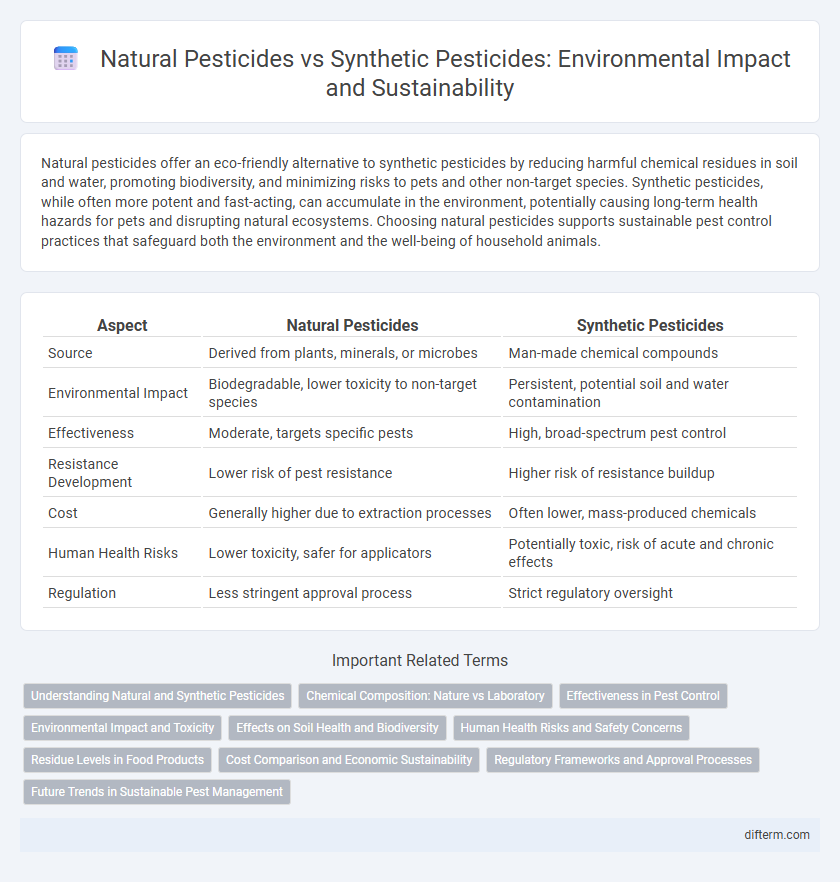Natural pesticides offer an eco-friendly alternative to synthetic pesticides by reducing harmful chemical residues in soil and water, promoting biodiversity, and minimizing risks to pets and other non-target species. Synthetic pesticides, while often more potent and fast-acting, can accumulate in the environment, potentially causing long-term health hazards for pets and disrupting natural ecosystems. Choosing natural pesticides supports sustainable pest control practices that safeguard both the environment and the well-being of household animals.
Table of Comparison
| Aspect | Natural Pesticides | Synthetic Pesticides |
|---|---|---|
| Source | Derived from plants, minerals, or microbes | Man-made chemical compounds |
| Environmental Impact | Biodegradable, lower toxicity to non-target species | Persistent, potential soil and water contamination |
| Effectiveness | Moderate, targets specific pests | High, broad-spectrum pest control |
| Resistance Development | Lower risk of pest resistance | Higher risk of resistance buildup |
| Cost | Generally higher due to extraction processes | Often lower, mass-produced chemicals |
| Human Health Risks | Lower toxicity, safer for applicators | Potentially toxic, risk of acute and chronic effects |
| Regulation | Less stringent approval process | Strict regulatory oversight |
Understanding Natural and Synthetic Pesticides
Natural pesticides, derived from plant extracts, minerals, or microorganisms, offer an eco-friendly alternative with lower toxicity and reduced environmental persistence compared to synthetic pesticides. Synthetic pesticides, composed of chemically engineered compounds, provide targeted pest control efficiency but often contribute to soil degradation, water contamination, and biodiversity loss. Understanding the chemical composition, environmental impact, and degradation rates of both types is essential for sustainable pest management and minimizing ecological harm.
Chemical Composition: Nature vs Laboratory
Natural pesticides derive their chemical composition from organic compounds found in plants, insects, and minerals, often consisting of complex mixtures like alkaloids, terpenoids, and essential oils that target specific pests with minimal environmental impact. Synthetic pesticides are formulated in laboratories using pure chemical substances, typically designed to be highly potent, stable, and broad-spectrum, but they may persist in ecosystems and potentially disrupt non-target organisms. The distinct chemical profiles influence degradation rates, toxicity, and environmental safety, highlighting crucial differences between nature-based and laboratory-produced pest control agents.
Effectiveness in Pest Control
Natural pesticides often target specific pests and decompose quickly, reducing environmental persistence but sometimes requiring more frequent applications for effective control. Synthetic pesticides tend to provide broader-spectrum pest control and longer-lasting effects, offering higher initial efficacy but increasing risks of resistance development. Integrated pest management strategies leverage the strengths of both types to optimize effectiveness while minimizing ecological impact.
Environmental Impact and Toxicity
Natural pesticides generally have lower environmental toxicity compared to synthetic pesticides, breaking down more quickly and minimizing long-term soil and water contamination. Synthetic pesticides often persist in ecosystems, causing bioaccumulation and harming non-target species such as pollinators and aquatic life. Choosing natural pesticides reduces ecological disruption and promotes biodiversity by maintaining healthier soil and water systems.
Effects on Soil Health and Biodiversity
Natural pesticides decompose rapidly, enhancing soil microbial diversity and maintaining nutrient balance, which supports long-term soil fertility. Synthetic pesticides often accumulate in the soil, disrupting microbial communities and reducing essential soil organisms, leading to diminished soil structure and fertility. The use of natural pesticides promotes biodiversity by minimizing exposure to toxic chemicals harmful to non-target species, whereas synthetic pesticides can cause significant declines in beneficial insect populations and soil fauna.
Human Health Risks and Safety Concerns
Natural pesticides generally pose fewer human health risks due to their biodegradability and lower toxicity levels, reducing the chances of acute poisoning and long-term illnesses compared to synthetic pesticides. Synthetic pesticides often contain chemical compounds linked to neurological disorders, endocrine disruption, and carcinogenic effects, raising significant safety concerns for agricultural workers and consumers. Choosing natural pesticides can mitigate exposure to harmful residues in food and water, supporting safer agricultural practices and public health outcomes.
Residue Levels in Food Products
Natural pesticides generally leave lower residue levels in food products compared to synthetic pesticides, reducing potential health risks for consumers. Studies reveal that synthetic pesticide residues can persist longer on crops due to their chemical stability, increasing exposure concerns. Regulatory agencies often set stricter residue limits for synthetic pesticides to ensure food safety and environmental protection.
Cost Comparison and Economic Sustainability
Natural pesticides often incur higher upfront costs due to limited availability and production scale, yet they offer long-term economic sustainability by enhancing soil health and reducing environmental remediation expenses. Synthetic pesticides generally present lower initial costs but can lead to increased expenditures over time from pest resistance, regulatory compliance, and environmental damage cleanup. Investing in natural pesticides supports sustainable agriculture economics by minimizing externalities and fostering ecosystem resilience.
Regulatory Frameworks and Approval Processes
Natural pesticides often face less stringent regulatory frameworks compared to synthetic pesticides, with agencies like the EPA applying expedited approval processes due to their biodegradability and lower toxicity profiles. Synthetic pesticides undergo rigorous testing for environmental impact, human health risks, and residue limits, often requiring extensive data submission and multi-phase risk assessments before approval. Regulatory differences influence market availability and usage patterns, impacting environmental sustainability and integrated pest management practices globally.
Future Trends in Sustainable Pest Management
Natural pesticides derived from botanical extracts and microbial agents are gaining momentum due to their biodegradability and reduced ecological toxicity compared to synthetic pesticides. Advances in biotechnology and precision agriculture are driving the development of bio-based pest control solutions that target pests more selectively, minimizing resistance and environmental impact. Emerging trends indicate a shift towards integrated pest management systems that combine natural pesticides with digital monitoring tools to enhance sustainability and crop resilience.
natural pesticides vs synthetic pesticides Infographic

 difterm.com
difterm.com